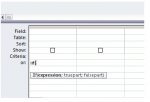Howdy guys,
hope this is the right place to post this.
I can't get this nested IIF to work; not sure what is wrong....
name: IIf(IsNull([TempVendorScopes].[vendor_standard]);IIf(IsNull([TempVendorScopes].[vendor_name_we]);[TempVendorScopes].[vendor_name];[TempVendorScopes].[vendor_name_we]);[TempVendorScopes].[vendor_standard])
I have a table TempVendorScopes with three columns:
- vendor_name
- vendor_name_we
- vendor_standards
vendor_name contains local (untranslated) vendor names
vendor_name_we is filled only when vendor_name was in a different language and vendor_name_we contains a translation of vendor_name.
vendor_standard contains a standardized name if different vendor_names and/or vendor_name_we address the same vendor.
For instance:
vendor_name...........vendor_name_we..................vendor_standard
1 kaas BV..................Cheese Ltd.........................
2 Cheese Inc......................................................Cheese Group
3 Fromage Paris..........Cheese Paris........................Cheese Group
I want the formula to return (when filled) vendor_standard, else (when filled) vendor_name_we and else vendor_name.
Thanks for your help!
Best,
S
hope this is the right place to post this.
I can't get this nested IIF to work; not sure what is wrong....
name: IIf(IsNull([TempVendorScopes].[vendor_standard]);IIf(IsNull([TempVendorScopes].[vendor_name_we]);[TempVendorScopes].[vendor_name];[TempVendorScopes].[vendor_name_we]);[TempVendorScopes].[vendor_standard])
I have a table TempVendorScopes with three columns:
- vendor_name
- vendor_name_we
- vendor_standards
vendor_name contains local (untranslated) vendor names
vendor_name_we is filled only when vendor_name was in a different language and vendor_name_we contains a translation of vendor_name.
vendor_standard contains a standardized name if different vendor_names and/or vendor_name_we address the same vendor.
For instance:
vendor_name...........vendor_name_we..................vendor_standard
1 kaas BV..................Cheese Ltd.........................
2 Cheese Inc......................................................Cheese Group
3 Fromage Paris..........Cheese Paris........................Cheese Group
I want the formula to return (when filled) vendor_standard, else (when filled) vendor_name_we and else vendor_name.
Thanks for your help!
Best,
S

